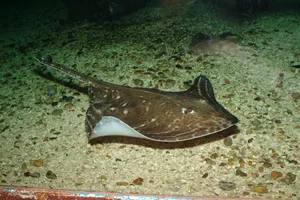- SEA LIFE Timmendorfer Strand, Rays

About thornback rays
In our oceans, but also in rivers there are almost 500 species of rays. Their nearest relatives are sharks. Just like sharks, rays have no skeleton. Their whole skeleton is made of cartilage and therefore very flexible. (On human bodies, for example, the nose and ears are made of cartilage.) The cartilage skeleton makes it easier for rays to glide through the water. They look like a bird flapping its wings.
Did you know that rays are masters of camouflage? They can adapt their coloration to the seabed and thus merge with it. With their very flat body, they hide from predators on the sea floor. However, if they feel threatened, they can also strike with their tail. Some species therefore have additional poisonous spines on their tail.
The thornback ray is the most common ray species in the European seas.